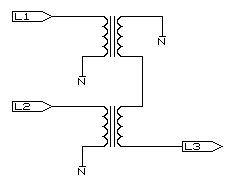|
WARNING: Voltages used are likely to be at lethal mains potential. Exercise extreme caution and have only qualified personel carry out permanent installation. The circuit shown below is not recommended for use where high currents are drawn or for legal monitoring purposes. Limitations are to be expected. During measurements or the testing of three phase equipment or when monitoring three phase supplies it is often found only two of the phases are available at 'safe' potentials of between 63 and 220 volts. This is usually due to the costs of the voltage transformers that reduce the incoming multi-kV to the levels mentioned. The following circuit generates the missing phase from the two supplied ones with sufficient power to drive 3 phase meter circuits and small instrumentation motors. It creates a new vector by addition of the supplied two. It will, however, be noticed the new phase is inverted (notice the phasing of the transformers), this is done to correct the polarity as the addition creates a vector ±60° from the two supplied when it should be ±120° to be correct.
The limitations of this circuit must be borne in mind before implementation as any impurities found on either of the two input phases will appear at the output and must not be used on capacitive voltage dividers - dangers exist with the LC circuit becoming resonant at an undesirable frequency and drawing excessive currents. The transformers are simple 1:1 isolation types chosen for the voltage and power used. It is recommended to not use miniture transformers (less than 5VA) as these tend to dissipate extreme amounts of heat and whose phase angles become significant in measurement systems. Oversized transformers will create lagged output angles that could affect power measurement readings.
© 14.08.00 |
